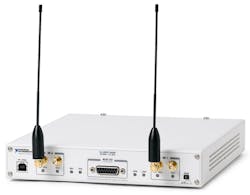This file type includes high resolution graphics and schematics when applicable.
Software-defined radio (SDR) has significant advantages, but design challenges exist that require the right tools to solve. National Instruments (NI) has many of these tools, including a new arrival.
I talked with James Kimery, director of marketing for RF Communications and Software Defined Radio, about the LabVIEW Communications System Design Suite (see “LabVIEW Tuned For Software Defined Radio”). It’s designed to work with NI’s Universal Software Radio Peripheral (USRP) RIO (see the figure).
Wong: Tell me more about the recently launched LabVIEW Communications System Design Suite.
Kimery: This past December, at GLOBECOM 2014, we unveiled the LabVIEW Communications System Design Suite. It’s a custom version of our LabVIEW system design environment targeted specifically at the communications design process and tuned to meet the needs of those developing new algorithms and real-time prototypes to evaluate novel design solutions. LabVIEW Communications provides an integrated, hardware-aware design environment with a cohesive design experience that enables researchers to quickly move from concept to real-world prototype.
Wong: What does LabVIEW Communications mean for communications designers?
Kimery: LabVIEW Communications is an integral element of NI’s broader SDR platform. Combined with NI’s SDR hardware, it helps researchers innovate faster. In the communications space, this means discovering new core, foundational technologies sooner and delivering much-needed solutions for increased bandwidth, security, coexistence, and other challenges. LabVIEW Communications is the design accelerator that will enable teams to outpace the competition and bring about the disruptive technologies that will fuel the Internet of Things.
Wong: Why is NI choosing to invest in this industry?
Kimery: Our mission at NI is to provide engineers and scientists with systems that accelerate innovation, productivity, and discovery. The communications industry is frantically investigating new technologies and modulation techniques to meet the growing bandwidth demands created by the explosion of connected wireless devices. Simply put, the tools and technologies in the market today are incomplete and insufficient to solve the challenge of 5G and other communications prototyping.
NI has been involved and invested in the wireless space for years. In 2010, NI acquired Ettus Research, the market leader in SDR. As our platform evolved, our understanding of this design space matured. And as our customers worked with us to improve our offering, we realized our platform-based approach is ideally suited to solve the challenges in this space. We developed LabVIEW Communications to better apply our leadership in FPGA technology and hardware/software integration to increase the pace of innovation in wireless design and research. We do this with the full belief that we have a big part to play in the innovation that delivers the next generation of wireless technology.
Wong: How is LabVIEW Communications different from previous versions of LabVIEW?
Kimery: There’s a growing trend in the market today that requires vendors to provide more solution-focused product offerings. These would enable engineers to focus on their specific areas of expertise instead of the semantics of the tools they use in the process. To better meet the needs of designers and researchers involved in communications, we had to go beyond our traditional offering to create a unique design flow suited for this type of rapid prototyping. Though LabVIEW Communications builds on previous versions of LabVIEW and many of the technologies already present in NI’s portfolio, we added several key innovations including:
- a design-centric editor
- communications-design optimized workflows
- a new multirate design language/canvas
- a hardware-aware design canvas
- integrated float-to-fixed and HLS tools
- LTE and Wi-Fi application frameworks
The LTE and Wi-Fi application frameworks have proven to be some of the most valuable new capabilities in this offering. These open-source, standards-based software stacks are ready to run out of the box. The application frameworks are designed to offer researchers a very productive starting point based on existing standards. Therefore, they can focus on their specific areas of innovation and ultimately shorten the path from initial concept to hardware prototype.
Wong: Who is the target audience for LabVIEW Communications?
Kimery: LabVIEW Communications is best suited for algorithm designers and communications-systems prototypers. From industry to academic, anyone involved in creating and refining new algorithms as well as testing these new algorithms with real-world signals is an ideal candidate for LabVIEW Communications. This contrasts with NI’s broader portfolio of RF instrumentation, which is targeted toward test-and-measurement applications, particularly in semiconductor and mobile-device manufacturing test. With LabVIEW Communications, the focus is entirely on the design side, where researchers are working on novel protocols, advanced signal processing, and communications design techniques.
Wong: What are some of the biggest challenges in prototyping promising 5G technologies?
Kimery: First and foremost, the design process from concept to hardware prototype is a critical challenge, and far too many researchers simply stop at software simulations. A key challenge for design teams is pushing the wireless research space to put greater emphasis on real-world prototypes and go beyond software simulations. For 5G to be realized, new candidate technologies must be vetted through the standardization process. Open standards enable multiple vendors to compete on an equal playing field.
An important step in the standardization process is presenting the governing bodies with data collected using real-world prototypes. The companies that can develop 5G technologies first stand to gain a substantial advantage in terms of time to market; therefore, companies working on 5G today must develop functional prototypes to further the 5G agenda while serving their own commercial interests.
Though industry laboratories understand the need for prototypes, academic and government laboratories must also embrace real-world prototypes. Some of the most impactful innovations of our time have been realized through collaborations in the public and private sectors. This is a challenge that we’re looking to address in some part with LabVIEW Communications: enabling stronger, more productive and efficient collaborations through a common platform. 5G presents several difficult challenges, and a broader community is essential to facilitate innovation along with widespread adoption, especially when scaling to the Internet of Things.
This file type includes high resolution graphics and schematics when applicable.
Beyond the challenges in design flow, many 5G research topics demand unprecedented timing and synchronization with proposed goals below 1-ms latency. Here, again, there’s a lack of tools that offer easy access to the advanced timing, triggering, and synchronization imperative to research topics such as Massive MIMO. As new solutions go beyond individual radios, we similarly require the technology and tools to operate at a system level and at a system-of-systems level.



